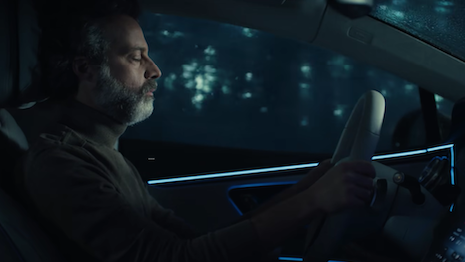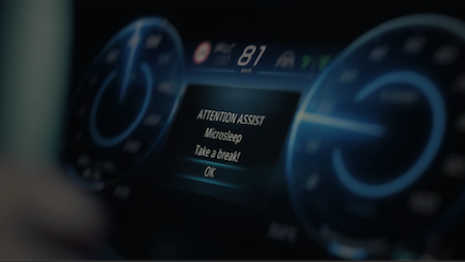 Mercedes-Benz invites audiences to discern what is real and what is not. Image credit: Mercedes-Benz
Mercedes-Benz invites audiences to discern what is real and what is not. Image credit: Mercedes-Benz
German automaker Mercedes-Benz is blending dreams and reality in a surreal spot focused on its new microsleep detection feature.
According to the automaker, more than a quarter of drivers experience microsleep — dozing off behind the wheel of a vehicle. Drawing attention to this issue while also promoting technological innovation, the “Awake” campaign offers a lesson in driver safety.
"Mercedes-Benz is known for its excellence in engineering and design quality, and this shows that Mercedes is leading the charge with this new active safety technology," said Julie Blackley, communications manager at iSeeCars, Boston.
"Active safety features were once considered novel, but now they have become common on all new vehicles," she said. "This shows that Mercedes is on the cutting edge of safety technology."
Awake
The nearly two-minute film opens with a man in his bedroom who appears to be in a state of psychosis. Shots of him playing with a small child, presumably his son, are interspersed to create a memory sequence.
In one of the shots, he puts the young boy in the backseat of a car and shuts the door. The next shot is of the man sitting up in his bed, rubbing his eyes.
The new spot brings awareness safe driving, while also promoting innovative features
The music intensifies and the man stands up to experience gusts of wind and leaves blowing through his room. With the visual effects, it becomes clearer that this could be a dream.
As the man confusingly wanders around his room and the wind picks up, his son shouts, “Daddy!” out of frame, and a beaming light comes through the window.
The next shot is of the man in the driver’s seat of his Mercedes-Benz EQS having fallen asleep at the wheel, with his son in the backseat — the same boy from the memory sequence. There is a beeping sound, and an alert appears on the dashboard: Attention Assist Microsleep.
He opens his eyes just before a large truck turns onto the road, allowing him enough time to safely break, bringing the vehicle to a stop. The man looks back at his son, who is visibly shocked, and looks back to the road contemplatively.
“Twenty-six percent of drivers experience microsleep,” appears across the screen. “Not all of them wake up again.”
 Driver safety is a top issue among automakers, and they continue to make advancements to ensure their customers are safe. Image credit: Mercedes-Benz
Driver safety is a top issue among automakers, and they continue to make advancements to ensure their customers are safe. Image credit: Mercedes-Benz
While it is a blunt and grim statement, it can entice audiences to reconsider best driving practices and their vehicle’s safety features.
According to the U.S. National Highway Traffic Safety Administration (NHTSA), nearly 100,000 police-reported fatigued-driving accidents result in about 800 fatalities and 50,000 injuries every year.
Safety first
While luxury automakers consistently promote the high-end experience of driving their top-of-the-line vehicles, safe driving remains a top priority.
German automaker Audi upgraded its car-to-X system to offer consumers real-time updates and warnings regarding slippery and challenging conditions.
Audi’s car-to-X service “Local Hazard Information” (LHI) uses a car-to-cloud application that can detect the tiniest changes in road surfaces, upload data to the cloud for processing and then warn upcoming drivers of road ice or disparate slippery driving conditions. The automaker improved the service with high-precision swarm data to make the driving condition warnings even faster and more precise (see story).
In a more creative manner, Toyota Corp’s Lexus aimed to shatter a misconception about texting and driving by bringing awareness to distracted driving with a new campaign.
According to the NHTSA, the average length of time it takes to send or receive a text message while driving is 4.6 seconds. In honor of Distracted Driving Awareness Month, Lexus wanted consumers to reflect on the choices they make while behind the wheels of their vehicles.
The “Driving Disrupted” film campaign demonstrated what happens when drivers can no longer see the road for 4.6 seconds. Participants got behind the wheel of a Lexus NX on a closed course, under the assumption they were taking the Lexus NX SUV for a routine test drive.
What they did not know was that they were driving a specially modified Lexus NX 4.6 model, equipped with electrochromic technology that could instantaneously turn the windshield and windows from transparent to opaque (see story).
"Consumers are drawn to safety features, but they have become so common that they are pretty much expected to be on all modern vehicles," Ms. Blackley said. "What is most compelling to consumers is having the latest and greatest safety technology."